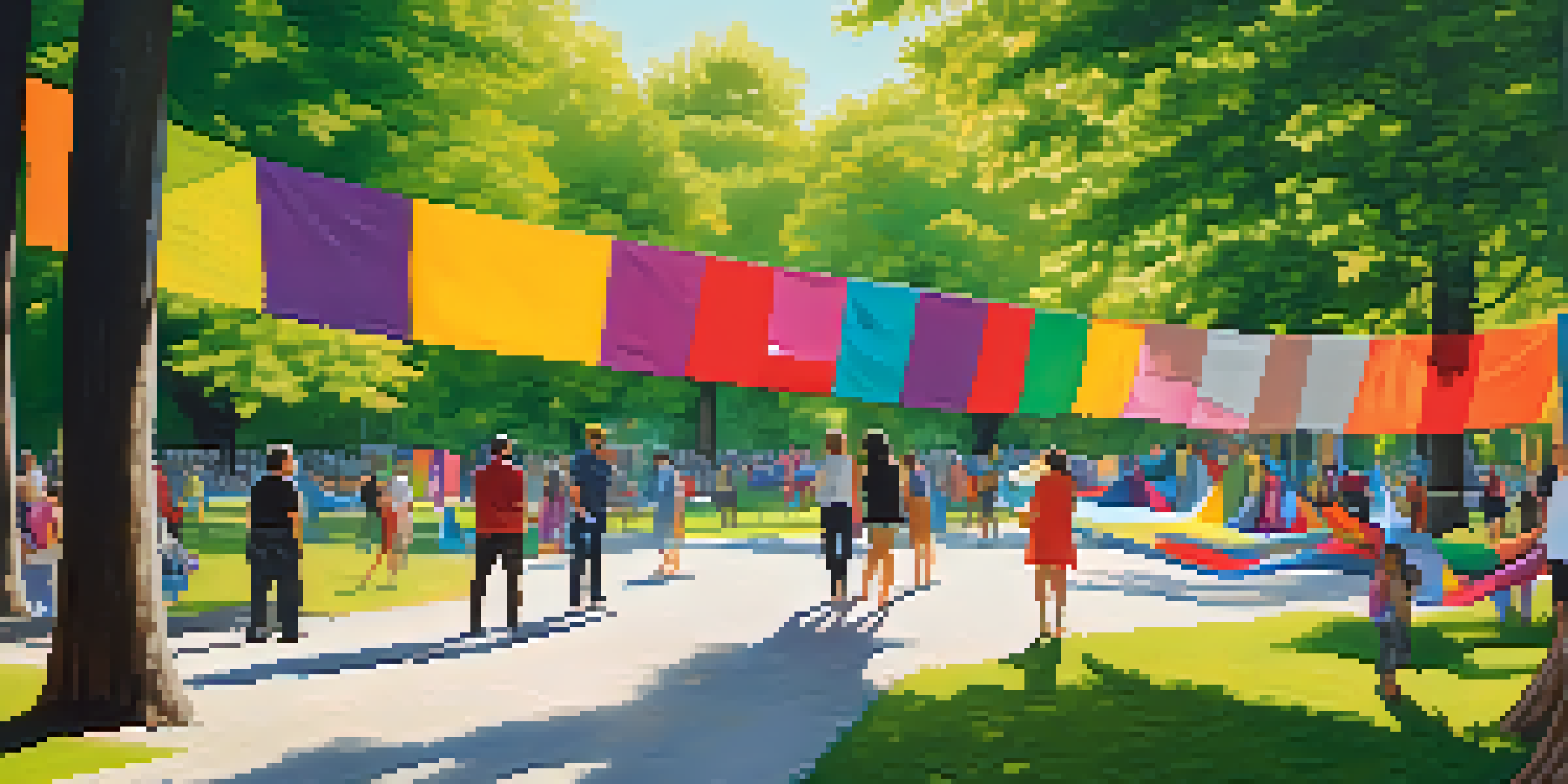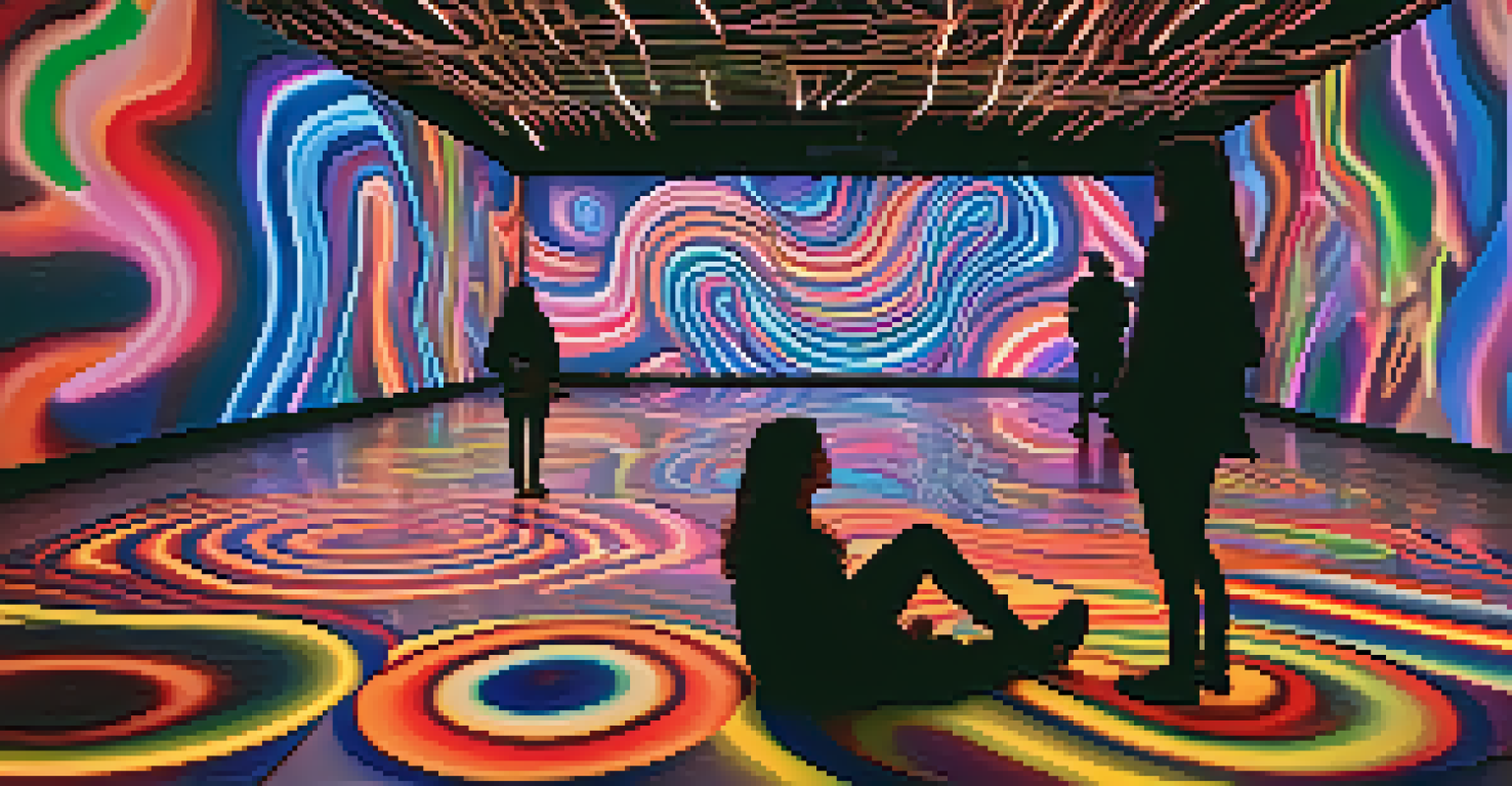Temporary Installations: Art that Makes a Short-lived Impact

What Are Temporary Installations in the Art World?
Temporary installations are artistic creations designed to exist for a limited time. These can range from large-scale sculptures in public spaces to immersive exhibits in galleries. Unlike traditional art pieces, which are often intended for permanence, temporary installations invite viewers to experience something unique and fleeting.
Art is never finished, only abandoned.
The essence of temporary art lies in its ephemerality; it captures a moment in time that can evoke emotions and provoke thought. Artists use various materials and techniques to create these installations, often incorporating elements of the surrounding environment. This connection to place can enhance the viewer's experience and create a deeper appreciation for the art.
Moreover, temporary installations can be a powerful way to draw attention to specific issues or themes. They often encourage interaction and engagement, making art more accessible to a broader audience. This aspect of accessibility is crucial, as it transforms a passive viewing experience into an active dialogue between the artist and the public.
The Role of Location in Temporary Art Installations
Location plays a pivotal role in the success and impact of temporary installations. An artwork placed in a bustling urban area can reach a diverse audience, while one set in a remote location may attract a more niche group. The choice of venue often complements the theme of the installation, enhancing the overall experience for visitors.

For instance, installations in natural settings can highlight environmental issues, while urban settings may focus on social commentary. This strategic placement not only amplifies the message but also allows the artwork to interact with its surroundings, creating a dialogue between nature, architecture, and art. It's this synergy that can make a temporary installation truly unforgettable.
Temporary Art's Unique Nature
Temporary installations offer a fleeting yet impactful experience, capturing emotions and provoking thought in viewers.
Additionally, the transitory nature of these installations can spark conversation about their significance long after they've been dismantled. Visitors often share their experiences on social media, extending the reach and impact of the artwork beyond its physical presence. This ripple effect underscores the importance of location in maximizing audience engagement.
Famous Examples of Temporary Installations
One of the most iconic temporary installations is Christo and Jeanne-Claude’s 'The Gates,' which adorned Central Park with 7,503 orange gates for 16 days in 2005. This project transformed the landscape of the park and attracted millions of visitors, proving that temporary art can leave a lasting impression. The sheer scale and vibrant color captured the imagination of New Yorkers and tourists alike.
The best artist has no conception that a marble block does not contain within it, and the only way to reveal it is to chip away the excess.
Another notable example is Olafur Eliasson’s 'The Weather Project,' displayed at the Tate Modern in 2003. This installation created a mesmerizing sun-like orb in an enclosed space, inviting visitors to lie down and contemplate their surroundings. By engaging the senses, Eliasson’s work encouraged a communal experience that lingered in the memories of those who visited.
These examples illustrate how temporary installations can challenge perceptions and foster connection. They remind us that art doesn’t always have to be permanent to be impactful; sometimes, the fleeting nature of a work can enhance its significance and deepen its resonance with audiences.
The Emotional Impact of Ephemeral Art
Temporary installations often evoke strong emotional responses, largely due to their fleeting nature. The knowledge that an artwork will only be around for a short time can intensify feelings of urgency and appreciation. Visitors may find themselves more present and engaged, knowing that they have a limited window to experience something extraordinary.
This emotional connection can be amplified through the themes explored in the artwork. For example, installations addressing social issues may provoke feelings of empathy and reflection, leading viewers to rethink their perspectives. By tapping into emotions, temporary art can inspire change, even if just in the minds of those who encounter it.
Location Enhances Art Impact
The success of temporary installations is heavily influenced by their location, as strategic placement can amplify their themes and audience engagement.
Ultimately, the emotional impact lies in the shared experience of witnessing something unique. When people come together to appreciate a temporary installation, they create a collective memory that can last long after the artwork has gone. This sense of community can be a powerful reminder of art's ability to connect us on a deeper level.
The Challenges of Creating Temporary Installations
Creating temporary installations comes with its own set of challenges. Artists must consider logistics, including funding, materials, and the installation process itself. The ephemeral nature of the artwork can also pose questions about its preservation and documentation, as many installations are dismantled shortly after their debut.
Weather can be another significant factor that impacts temporary installations, especially those set outdoors. Artists must account for environmental conditions that could affect their work, which can lead to unexpected complications. These challenges require creativity and adaptability, pushing artists to think outside the box to bring their visions to life.
Despite these hurdles, the rewards of creating temporary installations often outweigh the difficulties. The opportunity to engage with an audience and make a statement in a unique way can be incredibly fulfilling. For many artists, these projects represent a chance to break free from traditional constraints and explore new frontiers in art.
The Future of Temporary Art Installations
As the art world continues to evolve, the future of temporary installations looks promising. Innovative technologies, such as augmented reality and interactive media, are opening new avenues for artists to explore. These advancements can create immersive experiences that engage audiences in ways that traditional installations may not achieve.
Moreover, the growing emphasis on sustainability is influencing how temporary art is created. Artists are increasingly considering the environmental impact of their materials and processes, leading to more eco-friendly practices in the art community. This shift not only benefits the planet but also resonates with audiences who value sustainability.
Future Trends in Temporary Art
Emerging technologies and sustainability concerns are shaping the future of temporary installations, allowing artists to create more engaging and eco-friendly works.
As we look ahead, the potential for temporary installations to address pressing social and environmental issues will likely grow. Artists will continue to use their platforms to raise awareness and inspire action, making their work even more relevant in today's world. The future of temporary art is bright, and it holds the promise of impactful change.
How to Experience Temporary Installations
Experiencing temporary installations can be a thrilling adventure. To find out what’s happening near you, consider following local art organizations or visiting galleries that showcase temporary works. Social media is also a great resource, as artists often share their projects and locations online, allowing you to stay updated on new installations.
When you do visit a temporary installation, take your time to immerse yourself in the environment. Engage with the artwork, reflect on its meaning, and connect with others who are experiencing it alongside you. Sharing your thoughts and feelings can enrich your experience and help create a community around the art.

Finally, don't forget to capture your experience through photos or journaling. Even though the installation may be temporary, the memories and emotions you associate with it can last a lifetime. By documenting your experience, you contribute to the conversation around the artwork and keep its spirit alive in your own way.